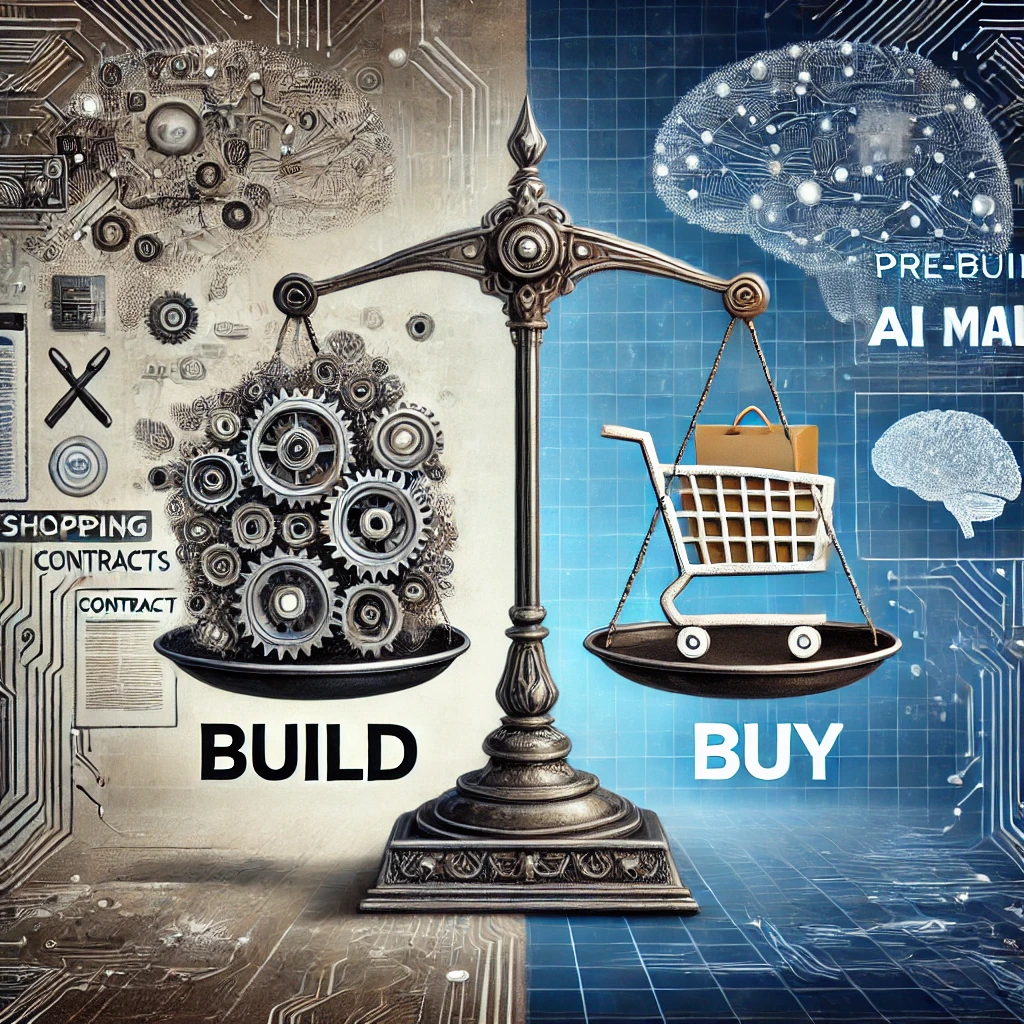A strategic guide to build vs. buy for GenAI
Generative AI has been transformational to the world already, and it’s just getting started. It has fast been adopted in multiple industries, from retail to healthcare and banking, offering multiple capabilities ranging from information retrieval, expert help, and new content creation. With the growing interest in GenAI from a majority of boardrooms, there is a big question that CTOs/CIOs are facing now: Should you build your GenAI application in house, or buy a pre-built solution?
This article provides a framework to help product managers, business-leaders and technology leaders navigate this decision. Please note that many of these fundamental arguments hold true for all decisions of build vs. buy, but we bring forward some nuances that are unique to the current landscape in GenAI.

The core of the decision
The build vs. buy (vs. modify, which I consider under the umbrella of buy) decision depends on multiple factors. What makes the decision even more difficult is that the AI landscape is fast-evolving, with new models and products launched every single week. What may be a gap in the market offerings today might see a new product in the next few weeks.
The key factors that impact this decision are:
- Market availability (now and in the near term) and business’s needed speed to market
- Strategic importance of the application to the business
- ROI for the business
- Risk and Compliance factors
- Ability to maintain and evolve
- Integration complexities

At the core, my personal advice is to reframe the build vs. buy question as why do you need to build? There are hundreds of amazing organizations pouring billions into the development of GenAI applications, so unless you are one of them, you should really try to understand what is out in the market that does not suit your needs.
The case for building GenAI applications
- Unique business requirements: If your needs are unique such that off-the-shelf applications in the market do not fit your needs, and you believe that no such applications will be in the market in the near to medium term horizon. Given the fast-paced nature of development in GenAI, I have personally seen instances where organizations started to build a functionality, only to see it being available as a commodity in the market within a few months. One example of this is evaluations, which saw a lot of launches from many key players in 2024, including AWS and Azure.
- Competitive Advantage: If the application is of strategic importance to your business and is critical for you to maintain your IP and market differentiation. These would be very unique circumstances in general and should have strong leadership alignment for this. One well-known example here is that of LLMs. Most organizations do not need to build their own LLM models; they can either use what is available in the market with well-engineered prompts, or fine-tune them to their own context. Bloomberg made a call to build their own model, which was a strategic move to enable the use of their proprietary data with a finance-specific lexicon while solidifying their position as a leader in financial innovation.
- Long-term cost efficiency: While upfront costs for development are higher, in-house solutions may be most cost-effective in the long run if your usage is large scale. One common pitfall here is not baking in the long-term maintenance overhead to the cost when building the business case. One must also note that even though many GenAI applications may be expensive now, the costs are falling rapidly as we speak, so what may look like an expensive buy now, may end up being cheap in a few months.
- Data Privacy and Security: Sensitive industries like healthcare and finance often have to abide by stringent data privacy regulations and concerns. In-house solutions provide additional control over data handling and compliance.
If you do end up deciding to build in-house, there are a few key challenges that emerge:
- You will need a skilled team of AI experts, substantial time, and significant upfront investment.
- Maintenance and updates, including abiding by the changing regulatory landscape become your responsibility.
- Even with the right team of experts, you may not be able to keep up with the speed of innovation that there is currently in GenAI.
The case for buying GenAI applications
Pre-built GenAI solutions, available as APIs or SaaS platforms, offer rapid deployment and lower upfront costs. Here’s when buying might be the better choice:
- Speed to market: if you are looking to deploy quickly, even if an existing solution may not be a 100% fit to your needs right now. With new developments and releases, new features may address more of your needs.
- Predictable costs: Subscription-based pricing models provide absolute clarity in terms of expense, avoiding cost overruns. On top of that, for GenAI, we have seen frequent price drops and expect that to happen in the near term. A recent example was that of Amazon Bedrock reducing pricing by 85%.
- Focus on core priorities: Buying allows your team to focus on business-specific tasks rather than the complexities of building AI. This is especially true of the solutions that are available as commoditized solutions and provide no competitive advantage.
If you do end up deciding to buy, there are a few key challenges that emerge:
- You may be limited by how much you can customize. There may be features you need, which remain on the vendor backlog for longer than you may want.
- Potential concerns around vendor lock-in and data privacy.
Key Questions to Guide Your Decision
The decision for build vs. buy for each GenAI application has to take into account the overall enterprise GenAI strategy for building vs buying. The decision cannot be made in isolation, as you need a critical mass of applications to justify having a team to build these. The following questions, however should be asked to help guide the answer for individual applications:
- Will this application enable a distinct competitive advantage?
- What solutions exist in the market already?
- What is your timeline for deployment?
- What capabilities are needed to build and maintain the GenAI application? Do you have that expertise, either internally or with partners?
- What are your data privacy and compliance requirements?
- How does the business case differ for build vs. buy?
Conclusion
The decision on build vs. buy decision for GenAI applications is not one-size-fits-all. The core of the decision-making strategy is not too different from any other build vs. buy decision, but GenAI applications have the additional complexities of a fast-changing landscape, a high pace of innovation and high-but-reducing costs of a relatively new technology.
While building offers control and customization at generally higher costs, buying provides speed and simplicity. Sometimes you may not have something available that fits your needs, but that may change in a few months. By carefully evaluating your organization’s needs, their urgency, resources, and goals, you can make a decision that drives success and long-term value.
The Build vs. Buy Dilemma for GenAI Applications was originally published in Towards Data Science on Medium, where people are continuing the conversation by highlighting and responding to this story.
Originally appeared here:
The Build vs. Buy Dilemma for GenAI Applications
Go Here to Read this Fast! The Build vs. Buy Dilemma for GenAI Applications